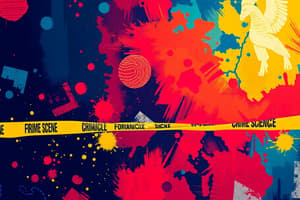Podcast
Questions and Answers
What is the primary goal of crime scene investigation?
What is the primary goal of crime scene investigation?
- To gather witness testimonies to build a case
- To convict a suspect based on circumstantial evidence
- To reconstruct the events leading up to the crime
- To collect and preserve physical evidence from the crime scene (correct)
What is the main focus of toxicology in forensic science?
What is the main focus of toxicology in forensic science?
- Analyzing fingerprints and DNA samples
- Studying poisons and their effects on the body (correct)
- Collecting fibers and textiles for analysis
- Reconstructing events leading up to the crime
What is the role of evidence collection in forensic science?
What is the role of evidence collection in forensic science?
- Gathering witness testimonies to support criminal investigations
- Identifying potential suspects based on circumstantial evidence
- Reconstructing the sequence of events at the crime scene
- Carefully collecting and documenting all potential evidence at the crime scene (correct)
Which aspect of forensic science involves documenting the crime scene with photographs and sketches?
Which aspect of forensic science involves documenting the crime scene with photographs and sketches?
What is the purpose of toxicology in forensic science?
What is the purpose of toxicology in forensic science?
What is the primary purpose of DNA analysis in forensic science?
What is the primary purpose of DNA analysis in forensic science?
What valuable information can be obtained through the study of fibers and textiles in forensic science?
What valuable information can be obtained through the study of fibers and textiles in forensic science?
What is the primary purpose of fingerprinting in forensic science?
What is the primary purpose of fingerprinting in forensic science?
How can pollen and spore examination be valuable in forensic science?
How can pollen and spore examination be valuable in forensic science?
Flashcards
Crime Scene Investigation
Crime Scene Investigation
Collecting and preserving physical evidence from a crime scene.
Evidence Collection
Evidence Collection
Careful gathering and documenting of evidence at a crime scene to avoid contamination.
Toxicology
Toxicology
Study of poisons and their effects on the body in forensic science.
DNA Analysis
DNA Analysis
Signup and view all the flashcards
Fiber and Textile Analysis
Fiber and Textile Analysis
Signup and view all the flashcards
Fingerprinting
Fingerprinting
Signup and view all the flashcards
Pollen and Spore Examination
Pollen and Spore Examination
Signup and view all the flashcards
Forensic Science
Forensic Science
Signup and view all the flashcards
HOSA Forensic Science
HOSA Forensic Science
Signup and view all the flashcards
Study Notes
HOSA Forensic Science
Health Occupations Students of America (HOSA) is a nationwide organization that promotes career opportunities in the healthcare industry. One of the career paths that HOSA offers is forensic science, which involves the application of scientific methods and techniques to gather and analyze evidence in criminal investigations. This article will explore the various aspects of forensic science, including crime scene investigation, evidence collection, toxicology, DNA analysis, study of fibers and textiles, fingerprinting, and pollen and spore examination.
Crime Scene Investigation
Crime scene investigation is the process of collecting and preserving physical evidence from the crime scene. This includes gathering information about the scene, such as the location, time, and circumstances of the crime, as well as documenting the scene with photographs and sketches. Investigators then collect and document physical evidence, such as bloodstains, fingerprints, and other potential evidence, to be analyzed later.
Evidence Collection
Evidence collection is a critical aspect of forensic science. Investigators must carefully collect and document all potential evidence at the crime scene, ensuring that it is not contaminated or destroyed. This may include collecting bloodstains, fibers, fingerprints, and other materials for later analysis.
Toxicology
Toxicology is the study of poisons and their effects on the body. In forensic science, toxicology is used to determine the presence of drugs or other substances in a person's body, which can help investigators determine the cause of death or the actions of a suspect.
DNA Analysis
DNA analysis is a crucial aspect of forensic science, as it can help identify individuals from biological evidence left at a crime scene. DNA analysis can be used to identify suspects, victims, or other individuals involved in a crime. This process involves extracting DNA from biological samples, such as blood or hair, and then analyzing the DNA to determine its unique characteristics.
Study of Fibers and Textiles
The study of fibers and textiles is used to identify and analyze fibers found at a crime scene. These fibers can provide valuable information about the clothing worn by suspects or victims, as well as other potential evidence. Fiber analysis can help investigators identify the source of the fibers, such as a particular type of fabric or a specific brand of clothing.
Fingerprinting
Fingerprinting is a well-known aspect of forensic science, as it is used to identify individuals from their unique fingerprints. Fingerprints can be used to match suspects to crime scenes or other evidence, and can provide valuable information about a person's involvement in a crime.
Pollen and Spore Examination
Pollen and spore examination is used to analyze pollen and spores found at a crime scene. These microscopic particles can provide valuable information about the environment and the time of year when a crime occurred. For example, the presence of certain types of pollen or spores can help investigators determine the time of year when a crime occurred or the location where the suspect spent time.
In conclusion, forensic science is a multifaceted field that involves various techniques and methods to gather and analyze evidence in criminal investigations. HOSA offers valuable resources and training for students interested in pursuing a career in forensic science, providing them with the knowledge and skills needed to excel in this exciting and challenging field.
Studying That Suits You
Use AI to generate personalized quizzes and flashcards to suit your learning preferences.



